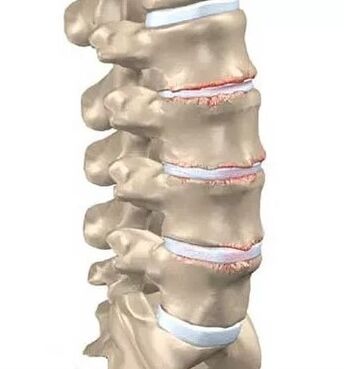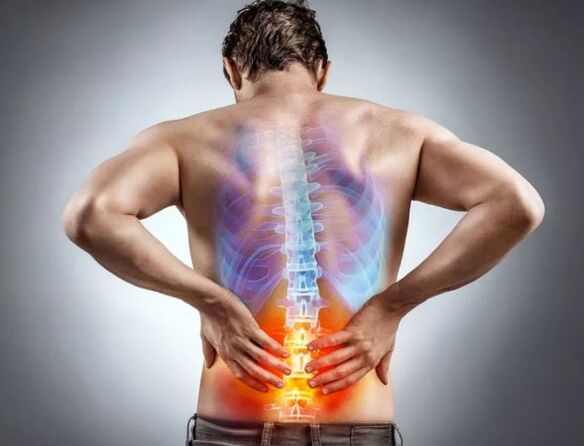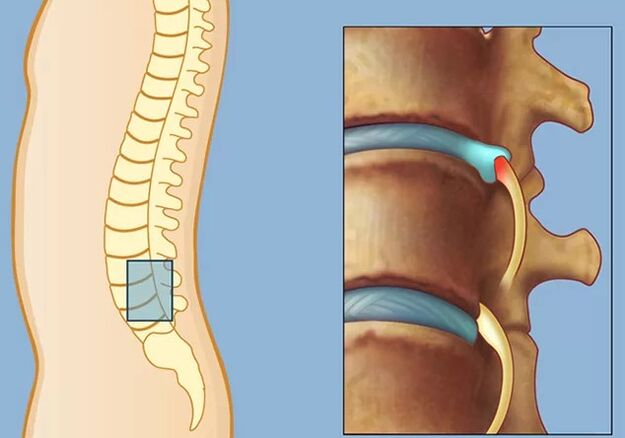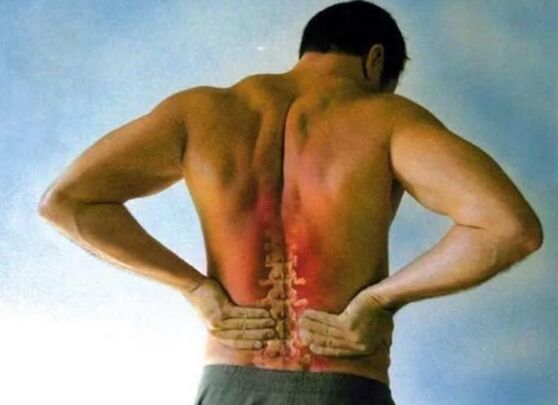The osteochondrosis of the lumbar column is a disease that is a special form of damage to the spine. Patients with this disease complain of rapid fatigue, back pain, legs, which cause motor activity limits. With osteochondrosis, there is a deformation of intervertebral discs, there is a decrease in their height, dystrophy and corakoid in the growth of the vertebrae. When they diagnose the X -ray, the Dyschaans are clearly visible.

The deformation of the cartilage tissue during the development of the osteocondrosis is a complex process, including biochemical and vascular changes. First of all, the fibrous ring is destroyed, following which the meatball is introduced. Consequently, the fibrous ring is torn and the hernia of the disc is formed. In this case, the low shine and low beloved segment is subject to the highest load. The hernia of the disc, which tightens the spinal cord or its roots, becomes the cause of back pain, which respond in the leg.
The most powerful sciatic nerve in the human body is formed by the sacral roots of the spinal cord. They are the ones, as well as low-liver, are irritated by osteochondosis. From the Latin name of the sciatic nerve, in relation to this, the second name of the disease was formed - Isia.
Due to the violation of the structure of the cartilage tissue, intervertebral discs, which are special cartilage structures, can no longer perform all their functions in full. This leads to the loss of flexibility and mobility of the spine. The processes, which in the initial stages of the disease influence only intervertebral discs, gradually apply to the vertebrae themselves.
The recording radicolite, which is considered one of the most common symptoms of osteocondrosis, is in almost every fifth person over the age of 30 in the world. At risk, people in working age are often at risk. Osteochondosis deprives the ability to engage in active activities and often causes disabilities.
Symptoms of lumbar osteochondosis
The main symptoms of lumbar osteochondrosis are serious back pain. However, in addition to this sign, there are a number of others. Therefore, patients suffering from this disease are quickly tired, they complain of headaches, fatigue and irritability. The discomfort in the back does not allow you to choose a comfortable position for sleep, so the body cannot completely relax and recover after the end of the day. The loss of resistance forces the patient to minimize physical activity and avoid pain. This leads to the fact that over time it does not become able to also carry out simple actions, for example, to provide your home needs.

The problems in the work of the parental parent system can also be one of the symptoms of lumbar osteochondosis. They appear in the form of pain in the kidney area. In patients with osteochondrosis, urination is interrupted, the unexpected presence of uncomfortable uncomfortable is possible. This leads to the instability of the vertebrae, which due to the deformation are not fixed by the intervertebral discs. The load on the spine causes the movement of the lumbar department from the sacred when the severity of the force is exposed to it. This process leads to damage to internal organs, problems in their work. In women, ovaries, appendices and uterus often suffer and the power is disturbed in men.
Osteocondrosis is characterized by an increase in the sensitivity of the legs, including stops, sides and lower legs. They are cramps that can lead to full loss of the impulse. The patient's skin with osteochondrosis on the legs is very dry, peeled and covered with throttling goose in the uncomfortable area. During pain attacks, sweating is disturbed.
All symptoms of osteocondrosis can be classified in the following groups:
Rook syndrome
The thinning of the intervertebral discs leads to the loss of stability vertebrae. After becoming mobile, they begin to be annoyed and squeezed the blood vessels and the nerve roots with acute movements and a strong physical effort. This process minimizes pain in the lumbar region, but resume with renewed vigor in which the nerve is compressed. The pain is acute and is piercing. The most very discomfort is expressed in the lower part of the leg, thigh, foot and buttock. The unpleasant sensations make the patient change the pace, leaning on the opposite side of the nerve.
When the nerve roots are irritated for a long time, their inflammation, swelling, venous stagnation and intoxication occur. The pain applies to the muscles, to ligaments. It is more acute in moments of physical activity, especially if it is carried out without hot -Up immediately after sleep or a rest of rest. Pain is often accompanied by an increase in sweating, which replaces the sensation of chills.
The manifestations of the root syndrome also include tingling, numbness and loss of sensitivity. The muscles lose the tone, therefore patients are not able to bear long -term physical activity, for example, descends and lift the stairs, get tired quickly. The functions of the pelvis are interrupted in particularly serious cases. In this case, the occurrence of paralysis and paresis is also possible.
Ischemic syndrome
Near the nerve roots are the blood vessels, which are compressed during the deformation. In the early stages of the development of the osteocondrosis, the arteries are crushed periodically, but then a spasm acquires a constant character. In this case, a "lome punctuation" occurs, the patient often must stop and rest with a long walk.
The closure of the blood vessels leads to the fact that the pelvic organs do not receive the necessary nutrients. This causes pain within the hips, perineum, in the buttocks up to their paralysis.
Vertebrate syndrome

Under the influence of pain, ischemic and rooting syndrome, the patient's skeleton with osteochondrosis is deformed. A person begins to bend over, has a pelvis and a spine, the muscles weaken, atrophy. All these changes influence the pace, which is adjusted according to the area of pain, becomes tense and uncertain. Gradually, the entire musculoskeletal system is exposed to osteochondrosis and intervertebral discs continue to collapse.
Pain syndrome (pain with lumbar osteochondosis)
Unpleasant sensations and discomfort in the rear are the main symptoms of osteochondosis. Nature and strength of pain change according to the stage of the development of the disease.
Initially, it is felt only in the lumbar region at the time of greater tension of joints, muscles and ligaments, that is, when performing physical effort. It can also be painful constant. But with the development of osteochondrosis, acute pain or movement also occur with sneezing, cough.
Palpation, as a rule, allows you to determine the seal in the muscles. An attack of pain can last several days and for all this time the patient must observe the rest in bed to minimize the unpleasant sensations in the rear. Any acute movements, weight lifting cause discomfort.
Causes of lumbar osteochondosis
The following main reasons for the development of lumbar osteochondosis are distinguished:
- Irregular load on the spine. According to experts, osteochondrosis is characteristic of a person as a biological species, since it is largely due to his lifestyle and his immediacy. The need to maintain the position of the body in a certain position requires a constant tension of the musculoskeletal system. The optimal load on the spine will be in an upright position. In a position lying on the back, it is minimal, on the side - a little more. But in a sitting position, the load on the lumbar column increases significantly. The inclination of the body forward creates an additional voltage for the front edge of the vertebrae and spine. Therefore, it is recommended to periodically change the position of the body, giving the muscles to relax and move the load on the spine and keep your back straight.
- Hypodynamia. A sedentary lifestyle, the use of a car and public transport, spends a great time for a computer and a TV - all this contributes to the development of problems with the spine, including osteochondosis. A significant part of the population lacks motor activity. A passive lifestyle leads to the fact that the musculoskeletal system weakens. In a sitting position, the spine is subject to the maximum load, this becomes the cause of the deformation of the cartilage tissue and, consequently, the osteochondosis of the lumbar region. Therefore, it is so important to rise periodically and perform a series of exercises. When a person spends a significant part of the time in a bent position, the flexive muscles stretch and lose their tone.
- Too high physical activity. The increase in motor activity, like its disadvantage, can also cause osteochondrosis. Back pain is often worried about athletes who are engaged in heavy athletic. This sport requires weight lifting, which creates further tension for the back muscles and causes the formation of intervertebral hernias.
- Incorrect posture. In the curved position of the spine, the load on it is distributed in a non -uniform way and this leads to the deformation of the intervertebral discs. The same influence is influenced by improper walk. People and the elderly fall into the risk group, since over time intervertebral records become less elastic, they lose their mobility and are more easily damaged.
- Defects of the bone system and genetic predisposition, injuries and infectious diseases. As a rule, osteochondrosis causes congenital problems with the musculoskeletal system. In addition, the cause of the disease can be the natural fragility of the cartilage. Osteochondrosis also develops as a complication after various damage to the spine, osteoomyelitis, tuberculosis.
- Feet dishes. In patients with plates, the set of foot does not perform amortization functions, as in the case in normal conditions. Therefore, when it moves, the whole load is taken on the intervertebral discs, due to which their rapid wear occurs.
- Overweight. Extra kilograms are an additional source of burden on the heart and bone muscle system, including the spine. According to statistics, people with overweight are more sensitive to various diseases.
- Inflammatory processes in the body. The development of osteocondrosis is facilitated by factors such as hormonal changes, problems with the joints of the spine, for example rheumatoid arthritis, the endocrine, digestive and cardiovascular system compromised.
- Life. Many patients do not pay attention to their health: they move little, they don't sleep enough, they eat incorrectly. This leads to an increase in fatigue, to the violation of the psycho -emotional state. All this makes the body very vulnerable and contributes to the development of lumbar osteochondrosis.

Degree of lumbar osteochondrosis
There are 4 degrees of lumbar osteochondrosis:
- The cracks appear inside the fibrous ring, which are filled with a substance from the nucleus of the jet, which causes irritation. At this stage, the deformation of the intervertebral records is scarcely expressed and manifests itself in the form of symptoms of the reflected boooleria. The patient can complain about pain in the heart, in the lower back. In the back of the cause of the discomfort, they become acute movements, weight lifting. Depending on the character, 2 types of pain are distinguished: lumbalia and lumbago. In the first case, it is stable and in the second it occurs suddenly;
- The destruction of the fibrous ring continues. However, there is a reduction in the gap between the vertebrae, the nerve endings are pinched. At this stage, a phenomenon such as pseudospondylolisthesis of the lumbar region is characteristic. This is the name of the process of moving the vertebrae with each other, which leads to pinch the nerve endings and cause pain. The spine is characterized by unusual mobility. With osteochondrosis of the 2nd degree of degree, patients complain of pronounced discomfort in the rear, in the lumbar region, heat and cold are warned alternately. Pain occurs with convulsions, during which goose skin appear on the skin and intensification intensifies;
- The fibrous ring is finally torn and the nucleus of the jacket is crushed outside. The Intermevertebral hernia appears. Taking the nucleus in the area of the spinal canal leads to squeezing the vases and roots of the spinal nerves.
The deformation of the spine is made up of lordosis, cifosis or scoliosis. With lordosis, the spine is converted forward. This violation of its normal position greatly complicates the work of the internal organs and their systems. With cifosi, the upper spine is curved and a feeling of bend down in advanced cases occurs. The lateral curvature occurs in the form of scoliosis. When a patient suffering from osteocondrosis with this curvature of the spine protrudes forward, asymmetry becomes evident thanks to the blade or protruding rib;
- The last phase of the osteocondrosis is the most dangerous, since the spine is finally deformed, which makes full motor activity impossible. Bone growth become evident on the radiography. Although pain does not disturb the patient for some time, this does not indicate an improvement. 4 degrees of osteochondrosis more often end up with disabilities.







































